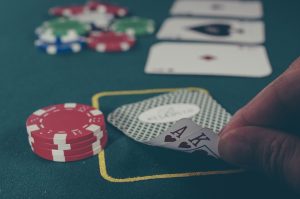 Poker is the highest form of art. Traditionally, the concept of art is limited to things like painting, music, and so on. However, occasionally you hear people talking about a beautiful baseball swing or a stunning mathematical proof. In poker, we also talk about beauty, although we use different words to describe it, such as “sick play,” “soul read,” and so on. The way we perceive beauty in poker is the highest form of mastery.
Poker is the highest form of art. Traditionally, the concept of art is limited to things like painting, music, and so on. However, occasionally you hear people talking about a beautiful baseball swing or a stunning mathematical proof. In poker, we also talk about beauty, although we use different words to describe it, such as “sick play,” “soul read,” and so on. The way we perceive beauty in poker is the highest form of mastery.
Where does creativity in poker come from? What is its role? And how can we develop our creativity?
Essentially, it is natural to be creative. When you first started playing poker, everything you did was creative. You experimented, made choices you hadn't made before, and weren't afraid. Only after a certain period of time, when you learned what not to do, your creativity was suppressed. Then you became a fully prepared, disciplined player. Now you don't even see how limited you are by your own conditioning. So, you can no longer see all the possibilities. When you encounter AA preflop, you don't see limping as an option; it has been completely dismissed.
Imagine poker as a vast field for a moment. Your “game” is a pattern of trodden paths in it, limiting the space available to you. Instead of allowing yourself to wander freely through this field, you now only walk the drawn paths. And this doesn't happen without reason. You try to protect yourself from negative EV. These structures become a self-imposed map, isolating you from losing money.
But once you have built a solid foundation for your knowledge, you realize that the game model you constructed is not perfect. You understand that your drawn path could be in better shape, in the form of a perfect poker game, but your path never becomes that. You suspect that in many places it is too short, and in some places too long.
Where does creativity come from? It comes naturally, through trial and error, playing and learning from the results. And while you are still creating your poker structure (when you are still deciding how to draw the network of paths), it is very easy to be creative, to test your limits. This is the easy part.
After the pattern is created and deeply embedded in your consciousness, creativity becomes a real challenge. If you perceive limping with AA as an unacceptable option, if you have removed it from all potential choices, how are you ever going to find out that limping in this case is the best option?
You probably started wondering why such a blunt example is used: “limping with AA is never the best decision.” That's exactly why it's a very good example. We all know that open limping with AA in cash games is never a good decision. But it is beyond our established game patterns, and such a model probably fits perfectly with a positive EV game. However, you never know which of your patterns is no longer compatible with positive EV; sometimes it can be as obvious as this one, saying not to limp with AA. Since it is already deeply ingrained in your game, it runs silently, like an unasked question, a tactical assumption.
It is usually obvious when you cross your limits. When you make bluffs that don't work or play in a way that is easy to counter, you immediately get negative feedback, so you understand that you need to step back. It's hard not to notice such spots in your game. But most of the time, the EV we criticize in bad spots hinders the EV we could have. Of course, we know nothing about this EV. Our mind gets no hints about EV that we don't even know exists. The only sign of crossed boundaries is a lower win rate.
You can't know where you cross your limits. This is the natural nature of a poker player. You lack value, but you don't know where. So, being creative means going and looking for that value. And the only way to discover new spaces is to cross old mental beliefs.
How does this manifest in reality? What does it mean to “cross old mental beliefs”? Crossing mental beliefs manifests as fear, a feeling that something is wrong, discomfort. It's the same feeling that stops you from overbetting the pot with two buy-ins, even if something tells you to do so. It's not that you quietly think to yourself, “this is negative EV,” although you might be able to convince yourself that you are thinking about it, but in reality, you decided before you did any mathematical calculations, your body reacted on its own. These physical, mental
reflexes are what we should focus our attention on.
Sometimes they are called emotional pain. This pain manifests when a potential play scares you. It's a lump in your throat. And it doesn't matter what you call this feeling – fear, discomfort, or something else. If you are a poker player, you understand what it's about. Of course, emotional pain is sometimes incredibly useful. It protects you from bad play. Without this pain, you would probably start making foolish moves out of boredom or curiosity. It's a subconscious method to regulate your game. When your consciousness disagrees with you, you feel stupid; when your subconscious does, you feel emotional pain.
You also feel this pain when you try to cross the network of established paths in your mind, so to develop creativity, you have to go through it. To cross your limits, you have to accept that lump in your throat. This feeling is just a signal that your subconscious thinks you are making a mistake. This is a signal that your mind has forbidden you to play this way.
However, you know that your game model is not perfect, and moreover, if you want to move forward, towards the best possible game, you have to familiarize yourself with this emotional pain. Feeling it is knocking on the door of creativity. If you play creatively, if you do something you've never done before, that “stone on your heart” is a sign that you have approached the boundary of your old game pattern. You have to be willing to feel this pain. Fear, pain, discomfort, are the only measures that help recognize your progress. You have to surrender to it. And finally, when you are ready, you have to cross the old game model and start creating a new one. This is the only way poker evolves. It seems that there have always been rules that were unshakeable – how to play preflop, what are the bet sizes, hand selection, but gradually all of this was rebuilt, daring to do more, to go further.





